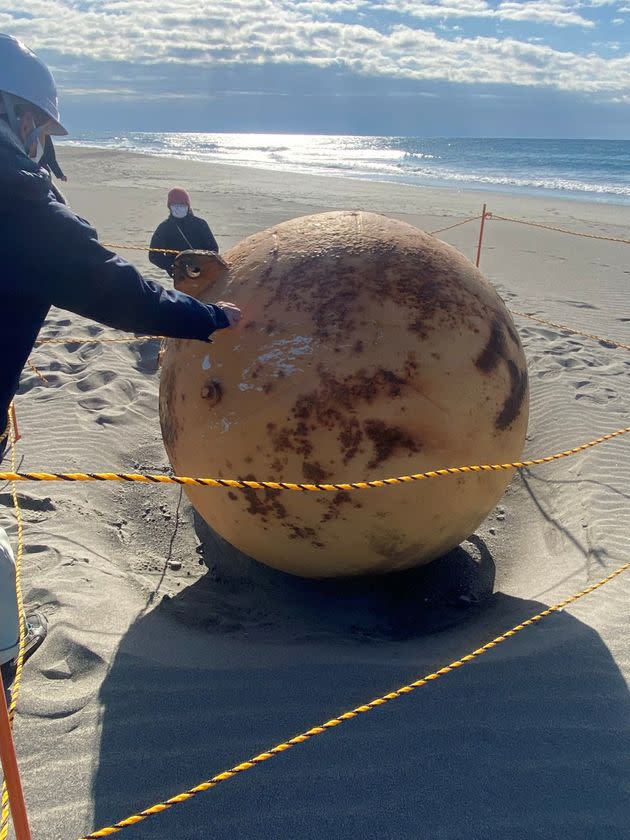Mysterious Metal Sphere Washes Up On Japanese Beach, Sparking Investigation
Mysterious floating spheres are having quite a month.
Just weeks after the military shot down a suspectedChinese spy balloon off the Carolina coast, a cryptic metal ball has washed ashore at Enshu Beach in the city of Hamamatsu on Japan’s Pacific coast, a Tokyo correspondent from The Guardian reports.

Authorities rope off and examine the sphere Wednesday on a beach in Hamamatsu, Japan.
The rusty, orange-tinted sphere — dubbed “Godzilla egg,” according to a BBC Tokyo correspondent — gained worldwide interest this week after a local resident spotted it and alerted police.
The elusive thingy is about 5 feet in diameter and has two raised handles, indicating that it can be hooked onto something else, the Guardian reported.
The call to authorities prompted police and even a bomb squad to investigate the object out of fear that it may be a stray mine, The Guardian said. Experts eventually deemed the object safe after X-rays found it was hollow. The Guardian also noted that there was no indication the object was part of any espionage operation from nearby North Korea or China.
The ball has been removed from the beach, according to the BBC.

Another view of the “Godzilla egg.”
Although the Dragon Ball Z-like figure is getting a ton of media attention, one local who regularly runs on Enshu Beach told public broadcaster NHK that it’s been sitting there for a while.
“It’s been there for a month,” he said. “I tried to push it, but it wouldn’t budge.”
Despite all this, police have not yet identified what the object is, which has some on social media questioning why authorities are staying quiet, the BBC reported. Based on a video posted of the sphere by NHK on Twitter, social media users believe it’s merely a ball buoy. Others have more whimsical ideas.
It's a steel mooring buoy. They are specially designed for the mooring of vessels in the most economical way while protecting shorelines, natural habitats & other boats by giving those sailing or stationed an alternative anchoring point for all types of vessels. pic.twitter.com/PBU4l1anvJ
— Jeremiah Garcia (@jeremiah_fsp) February 21, 2023
I found one buried in my backyard some years ago. That one at least has some mystery to it - because that's not where I'd go looking for a buoy! 😁 pic.twitter.com/mto4ErRI8t
— gummih 🦣$8️⃣ (@gummih) February 22, 2023
I can't believe officials from a country surrounded by ocean don't recognize a ball buoy. 🤦♂️
They seemed rather intrigued by the mooring loop. 🧐— Efren Mendez, Jr. (@EfrenMendezJr) February 21, 2023
Obviously pic.twitter.com/fWLAfjimZA
— Orb Tronik (@OrbTroNik) February 21, 2023
— Anthony G (@Tony323g) February 21, 2023
Hamamatsu’s civil engineering office said it “considers it to be a foreign-made buoy,” the BBC reported.
Mark Inall, an oceanographer at the Scottish Association for Marine Science, told the BBC that, although he knew “instantly” it was a buoy, he understood why people might confuse it for a World War II mine.
“But those would have spikes sticking out of them,” he said.
Inall told the BBC that these buoys often wash up in Scotland and that they can float in the sea for decades, which causes their markings to fade.

